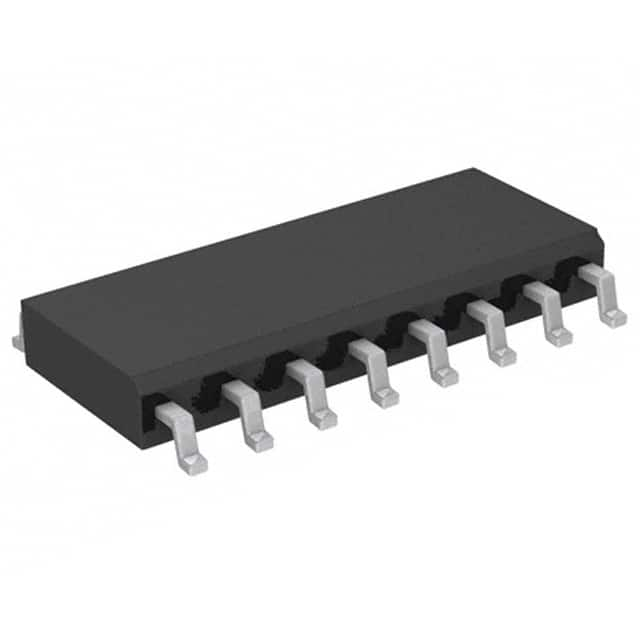MM74HC4046M
Overview
Category
MM74HC4046M belongs to the category of integrated circuits (ICs).
Use
It is commonly used as a phase-locked loop (PLL) for frequency synthesis and demodulation applications.
Characteristics
- High-speed operation
- Low power consumption
- Wide operating voltage range
- Small package size
- Easy integration into electronic systems
Package
MM74HC4046M is available in a small outline integrated circuit (SOIC) package.
Essence
The essence of MM74HC4046M lies in its ability to generate stable and precise output frequencies based on input signals.
Packaging/Quantity
This product is typically packaged in reels or tubes, with a quantity of 250 units per reel/tube.
Specifications and Parameters
- Supply Voltage: 2V to 6V
- Operating Temperature Range: -40°C to +85°C
- Input Frequency Range: DC to 10MHz
- Output Frequency Range: DC to 10MHz
- Phase Comparator Frequency Range: DC to 10MHz
- Lock Range: ±5% of VCO Center Frequency
Pin Configuration
The pin configuration of MM74HC4046M is as follows:
- VCO IN
- GND
- VCO OUT
- VCO CTRL
- PHASE COMPARATOR INPUT
- PHASE COMPARATOR OUTPUT
- EXTERNAL CAPACITOR
- VCC
Functional Characteristics
MM74HC4046M offers the following functional characteristics:
- Phase comparator with two inputs and one output
- Voltage-controlled oscillator (VCO)
- External capacitor for frequency control
- VCO control input for fine-tuning
Advantages and Disadvantages
Advantages
- High-speed operation allows for quick frequency synthesis
- Low power consumption for energy-efficient designs
- Wide operating voltage range enables compatibility with various systems
- Small package size facilitates integration into compact electronic devices
Disadvantages
- Limited lock range may restrict certain frequency synthesis applications
- Input and output frequency range limited to DC to 10MHz
Applicable Range of Products
MM74HC4046M is suitable for a wide range of products, including: - Communication systems - Frequency synthesizers - Demodulation circuits - Clock generation circuits - Phase-locked loop (PLL) applications
Working Principles
The working principle of MM74HC4046M involves the phase comparator comparing the phase difference between the input and feedback signals. The VCO generates an output frequency based on the control voltage applied. The external capacitor helps fine-tune the output frequency.
Detailed Application Field Plans
MM74HC4046M can be applied in various fields, such as: 1. Wireless communication systems: Used for frequency synthesis in wireless transceivers. 2. Audio equipment: Utilized for demodulation in FM radio receivers. 3. Clock generation circuits: Employed to generate stable clock signals in digital systems. 4. Data transmission systems: Used for synchronization purposes in data communication. 5. Test and measurement instruments: Applied for frequency synthesis and signal demodulation.
Detailed Alternative Models
Some alternative models to MM74HC4046M include: - CD4046B - MC14046B - HEF4046BP - SN74HC4046AN - HCF4046BE
5 Common Technical Questions and Answers
Q: What is the maximum operating voltage for MM74HC4046M? A: The maximum operating voltage is 6V.
Q: Can MM74HC4046M operate at temperatures below freezing point? A: Yes, it can operate in a temperature range of -40°C to +85°C.
Q: What is the purpose of the external capacitor in MM74HC4046M? A: The external capacitor helps control the frequency output of the VCO.
Q: Can MM74HC4046M be used for frequency synthesis above 10MHz? A: No, the input and output frequency range is limited to DC to 10MHz.
Q: How many pins does MM74HC4046M have? A: MM74HC4046M has a total of 8 pins.
This encyclopedia entry provides an overview of MM74HC4046M, including its category, use, characteristics, package, essence, packaging/quantity, specifications and parameters, pin configuration, functional characteristics, advantages and disadvantages, applicable range of products, working principles, detailed application field plans, alternative models, and common technical questions and answers.


